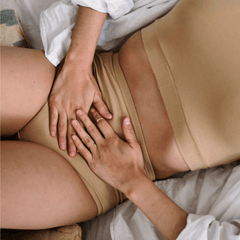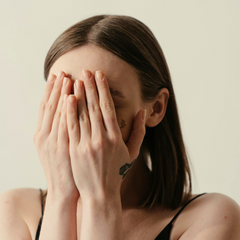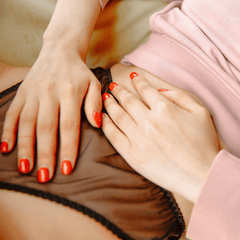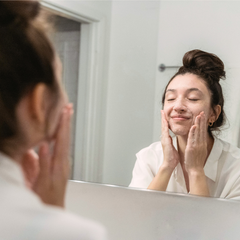The Best AM & PM Skincare Routine for Hormonal Acne

Struggling with hormonal acne and wondering what the right skincare routine looks like? Hormonal acne can feel like a never-ending cycle—just when your skin starts to clear, the chin and jawline breakouts come back. You've probably tried everything from harsh cleansers to trendy serums, only to feel frustrated when the results don’t last.
Here's the truth: topical skincare alone won't fix hormonal acne. The right topical products can help, but for long-term results, you need to identify and address the internal root cause of your hormonal acne. That said, a quality skincare routine is still an important part of healing acne, and the right (or wrong) skincare routine can make a big difference. In this in-depth guide, we’re going to break down the best AM and PM skincare routine for hormonal acne that helps deep clean pores, calm active breakouts, minimize hyperpigmentation and scarring, and maintain clear skin, all while working hand-in-hand with internal strategies that tackle the root cause.
Let’s dive in.
What Is Hormonal Acne?
Hormonal acne is caused by hormone imbalances that increase the oil-stimulating androgen, DHT. Common acne-causing hormone imbalances include high estrogen, low progesterone, and high androgens. By raising DHT, these hormone imbalances increase the skin’s oil production, clog pores, and enhance bacterial growth, leading to breakouts.
Common Causes of Hormone Imbalances
-
Diets containing lots of high-glycemic, processed, or chemically-treated food
-
Endocrine disrupting chemicals
-
Medication, like hormonal birth control
-
Chronic stress
-
Poor detoxification (usually tied to poor gut or liver health)
-
Excess body fat
-
Genetics
Signs Your Acne Is Hormonal
-
Breakouts persist past your teen years into adulthood
-
Breakouts are concentrated on the lower half of the face, typically around the mouth, chin, jaw, and lower cheeks
-
Cyclical flare-ups (e.g., before your period)
-
Acne doesn't respond to topical treatments and/or medication
-
Often consists of deep, painful cysts
Why Skincare Still Matters for Hormonal Acne
Addressing the internal root cause of your hormonal acne is the most important step in preventing breakouts. However, topical skincare can help manage the immediate, visible effects of hormonal acne. While it may not completely stop new pimples from forming, a well-designed skincare routine helps keep skin clean and calm while you're working on restoring balance within your body. Skincare can provide daily support in:
-
Clearing active breakouts
-
Preventing clogged pores
-
Reducing inflammation
-
Fading dark spots and scarring
-
Maintaining a healthy skin barrier
To ensure your skincare is doing more good than harm, it’s crucial that all your products are free from endocrine-disrupting chemicals (EDCs) like parabens (e.g., methylparaben, ethylparaben, butylparaben), phthalates, and synthetic fragrances. These can interfere with your hormones and worsen acne-related hormone imbalances. Opting for plastic-free packaging is also your best choice, as plastic can contain harmful EDCs like BPA.
The good news is that there are natural, gentle ingredients that can be just as effective as chemical-based ones. To learn more, check out this guide to the Best Natural Topical Ingredients for Hormonal Acne.

Skincare Routine for Hormonal Acne
Step 1: Cleanser
Be sure to use a gentle cleanser to avoid stripping the skin. This is one of the most important things to get right in your skincare routine. Whether it’s morning or night, your cleanser should clean without leaving your skin feeling tight, dry, or irritated. Harsh cleansers can disrupt your skin’s natural moisture barrier, leading to an overcompensation of oil, and more breakouts. Gentle cleansers are also more likely to maintain your skin’s pH balance.
Cleansing in the morning isn’t necessary for everyone. Many people find that cleansing only in the evening works best to maintain their skin’s natural balance. It’s worth experimenting to see what feels right for your skin and how it reacts throughout the day, whether that means a full morning routine, a splash of water with moisturizer, or nothing at all.
At night, a double cleanse can be extremely beneficial when cleansing, especially if you’re wearing makeup. We recommend starting with an acne-safe oil cleanser—massage into dry skin, add some water to emulsify, continue massaging, and then rinse off. Repeat with a gel or cream cleanser, as these are often the most gentle.
Skincare Routine:
-
AM: Optional
-
PM: Essential—helps remove sunscreen, makeup, sweat, and impurities from the day
Look for:
-
Oil cleansers that contain acne-safe oils like jojoba oil, raspberry seed oil, evening primrose oil, sweet almond oil, or grapeseed oil
-
Gel or cream cleansers that contain gentler acne-fighting ingredients like salicylic acid, tea tree oil, or niacinamide
Avoid:
-
Using scrubs or cleansers with physical exfoliants on a daily basis
-
Cleansers with harsh active-ingredients like benzoyl peroxide, which has been linked to the carcinogen benzene
-
Cleansers containing Sodium Lauryl Sulfate (SLS) and Sodium Laureth Sulfate (SLES)—these are hormone-disrupting foaming agents often found in cleansers
Step 2: Toner or Hydrating Mist
A toner can help hydrate and calm the skin, while prepping it for better absorption of treatments—like a damp sponge, damp skin is more easily able to absorb fluids. Spray formats tend to be gentler and are great for sensitive skin, while applying with a cotton round may offer light exfoliation, which is helpful for more congested skin. Experiment to see what feels best for you.
Skincare Routine:
-
AM: Optional
-
PM: Optional
Look for:
-
Spray or pump-style application if your skin is prone to irritation or inflammation
-
Hydrating, acne-fighting ingredients like rose water, hyaluronic acid, or aloe vera
Step 3: Targeted Serum or Treatment
This step can help target and treat active pimples as well as acne-induced hyperpigmentation. In the morning, it’s important to choose a treatment that won’t make your skin more prone to sunburn, irritation, or long-term damage, and to always follow up with a broad-spectrum sunscreen. At night, we recommend sticking to one active ingredient at a time. Alternate nights to avoid overdoing it, especially if you want to use a variety of active ingredients.
Skincare Routine:
-
AM: Optional
-
PM: Optional
Look For:
-
Niacinamide, which is sebum-regulating, anti-inflammatory, and great for active breakouts and large pores
-
Azelaic acid, which is antibacterial, brightening, and great for active breakouts and hyperpigmentation
-
Vitamin C, which brightens skin tone, supports collagen production, and is great for hyperpigmentation and scarring
-
Retinoids, which promotes cell turnover and reduces clogged pores, but isn’t recommended for AM use
Avoid:
-
Applying photosensitizing ingredients during the day like retinol or exfoliating acids (AHAs, BHAs)
-
Combining multiple actives at once
-
Acne treatments with benzoyl peroxide, due to its link to benzene
Step 4: Moisturizer or Face Oil
This step is very important. If you’re not replenishing your skin after cleansing, it may start producing excess oil to compensate for the lack of moisture.
Your skin needs both water and oil to stay healthy and balanced. Moisturizers are typically a 2-in-1 product that combines both water-based and oil-based ingredients. However, you can break these components into two separate steps to more effectively optimize hydration and moisturization.
-
Option 1: Moisturizer
A good moisturizer combines water-based hydration and oil-based nourishment. Think of moisturizer like a 2-in-1 shampoo/conditioner. It’s a simple yet effective option for most people. -
Option 2: Separate Hydrating and Moisturizing Products
Breaking up these steps can help amplify hydration and moisture. Start with a water-based product (like a hydrating toner or a water-based serum) to deliver hydration. Then, follow it with a face oil for moisture. Always apply your face oil on damp skin, after hydrating. Since oil cannot be penetrated, this helps to lock in the hydration, preventing evaporation.
If you're hesitant about using oil on acne-prone skin, you're not alone. Many people worry that oils will clog pores and exacerbate acne. Fortunately, not all oils are created equal. There are certain oils with small molecules that are safe for acne-prone skin, such as jojoba oil, squalane, or rosehip oil. These oils mimic your skin’s natural sebum and are non-comedogenic, meaning they won’t clog pores. On the other hand, oils like coconut oil, which have larger molecules, can clog pores and aggravate breakouts. That said, you can always stick with a facial moisturizer if you’re concerned.
Skincare Routine:
-
AM: Optional
-
PM: Essential—keeps skin hydrated and moisture barrier intact
Look for:
-
Formulas that align with your skin type—lightweight formulas for oily skin, richer formulas for dry skin
-
Formulas that align with usage timing—lightweight for AM, richer for PM
-
Hydrating and moisturizing acne-fighting ingredients like hyaluronic acid, squalane, or ceramides
Step 5: Sunscreen
Always apply sunscreen, particularly when using acne treatments that make skin more sun-sensitive. For optimal skin and hormone support, choose a mineral sunscreen with broad-spectrum protection and SPF 30 or higher. If you’re unsure where to start, check out our guide to hormone-safe sunscreens that won’t trigger breakouts.
Skincare Routine:
-
Morning: Essential
-
Night: N/A
Look for:
-
Mineral sunscreens with broad-spectrum and SPF 30 or higher
-
Water-resistant if sweating or swimming
Weekly Add-Ons for Hormonal Acne
Exfoliation (1–2x/week)
Gently sloughing off dead skin helps prevent the build up that leads to clogged pores and dullness. However, too much exfoliation can disrupt the skin’s natural moisture barrier. The type of exfoliant depends on your skin. Many prefer physical exfoliants, but chemical exfoliants are a more gentle option that’s great for inflamed or sensitive skin.
Look for:
-
Mandelic acid, which has antibacterial properties
-
Lactic acid, which hydrates while exfoliating and is ideal for dry skin
-
Fruit enzymes (papaya, pineapple, pumpkin), which offer ultra gentle exfoliation
Mask (1x/week)
Weekly masking can support a deeper cleanse, a calming effect, or a boost of hydration and moisture, depending on the ingredients used. A good mask should support your skin without stripping it. Apply after cleansing, leave on for 10–15 mins, and follow with the rest of your routine.
Look for:
-
Manuka honey, which is naturally antibacterial, soothing, and moisturizing
-
Kaolin clay, which is a gentle clay that draws out impurities and helps balance oil
-
Aloe vera, which hydrates and heals while reducing redness
-
Green tea, which is rich in antioxidants, helping calm inflammation and fight breakouts
Pimple Patches
These tiny stickers work amazingly well to absorb pus and oil, flatten spots, and prevent picking (which can lead to scarring). Cleanse skin before applying and leave on for at least 6 hours (or overnight).
Look for:
-
Hydrocolloid patches, which include a substance that helps to create a healing environment for whiteheads or pimples that are just about to surface
-
Microdart patches, which make it easier for acne-fighting ingredients to penetrate under the skin of deeper, cystic pimples
Internal Support (The Missing Piece)
A topical skincare routine helps manage breakouts, but true healing requires addressing the root cause—internal hormonal imbalances. We’ve got a full article to guide you through the first step—identifying which hormone imbalance is behind your acne. For a more personalized approach, take our free hormone imbalance quiz to get insight into what might be going on with your hormones. Regardless of the imbalance, here are a few key cornerstones of a supportive diet and lifestyle for hormonal acne.
1. Organic, Whole Foods
Choose organic, whole foods as much as possible and moderate your intake of high-glycemic, processed, or chemically-treated foods. Incorporate lots of quality protein, fibre-rich foods, and healthy fats to support detoxification and optimize hormonal support.
2. Hormone-Safe Personal Care & Household Products
Reduce your exposure to endocrine-disrupting chemicals by avoiding plastics and choosing clean formulas, including personal care, household, and food products. You should be able to understand everything on the ingredient labels.
3. Stress Management
Prioritizing sufficient quality sleep and exercising regularly are two simple ways to help manage stress levels. Incorporating relaxation techniques into your day, like breathwork, yoga, or meditation, can also help.
4. Detoxification Support
Supporting your liver and gut allows these crucial organs to more effectively detoxify toxins and excess hormones. Protein, antioxidants, fibre, and probiotics all play an important role in enhancing liver and gut function, while excess caffeine, alcohol, and medication can do the opposite. Plenty of water is also important!
If you’re dealing with hormonal acne caused by high estrogen, cruciferous vegetables (like broccoli, kale, and cauliflower) provide a natural compound called DIM, which helps break down estrogen during the first phase of detox. Our best-selling hormonal acne supplement, Balance, is formulated with 150mg of DIM, giving you a potent dose of DIM, along with other detox-supporting ingredients, to boost your body’s ability to process and eliminate excess estrogen.
Skincare Alone Isn’t Enough—But It Matters
If you’ve been stuck in the cycle of buying new skincare products hoping this one will finally be the answer, know this:
Topical products can’t fix hormonal acne alone, but they are a powerful support system when paired with internal balance.
Focus on keeping skin clean and calm, and staying consistent. And if you’re unsure why your breakouts are happening in the first place? Take our naturopath-designed hormone imbalance quiz to find out what’s really going on beneath the surface. From there, you can explore whether our hormonal acne supplement, Balance, is right for you.
Because your skin deserves more than another harsh, irritating cleanser. It deserves true support, inside and out.





